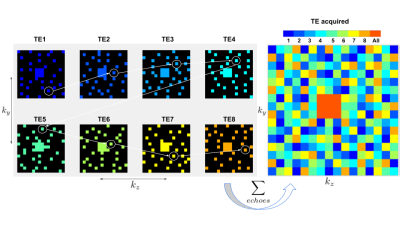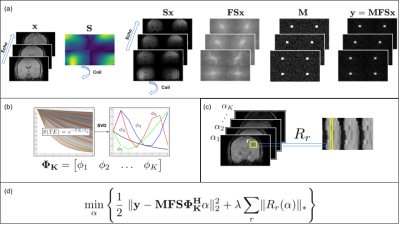Charles Iglehart1, Ali Bilgin1, Evan Levine2, and Manojkumar Saranathan3
1Electrical and Computer Engineering, University of Arizona, Tucson, AZ, United States, 2Microsoft Research, Redmond, WA, United States, 3Department of Medical Imaging, University of Arizona, Tucson, AZ, United States
1Electrical and Computer Engineering, University of Arizona, Tucson, AZ, United States, 2Microsoft Research, Redmond, WA, United States, 3Department of Medical Imaging, University of Arizona, Tucson, AZ, United States
We have successfully shown proof of concept of a novel means of accelerating $$$T_{2}^{*}$$$ mapping via CPD-based undersampling and ADMM reconstruction. Parameter estimates from reconstructed images exhibit excellent performance at $$$R=6$$$ and acceptable performance at $$$R=8$$$

Figure 1. Sampling via CPD. Each $$$(k_{y},k_{z})$$$ point is acquired exactly once along the echo dimension, save for a fully sampled 24 by 8 central region. This allows full sampling of k-space with incoherent sampling at each TE while promoting temporal sparsity. For a single echo train (white arrows), successive echoes are acquired within a constrained k-space neighborhood to minimize eddy currents. This results in approximate $$$R=ETL$$$ acceleration. To obtain different acceleration rates, new sampling patterns are generated and set unioned with the existing pattern.

Figure 2. Sampling and reconstruction. (a) ME GRE images ($$$\mathbf{x}$$$) are multiplied by coil sensitivities ($$$\mathbf{S}$$$) and Fourier Transformed ($$$\mathbf{F}$$$). CPD masks ($$$\mathbf{M}$$$) are applied to produce the undersampled data array. (b) Singular Value Decomposition on 5000 signal evolutions with $$$T_{2}^{*}$$$ selected between $$$0.1$$$ and $$$2000$$$ ms generates a temporal basis. The $$$K$$$ principal components ($$$\mathbf{\phi}$$$) with the largest singular values are selected as a truncated basis. (c) Locally low rank regularization.